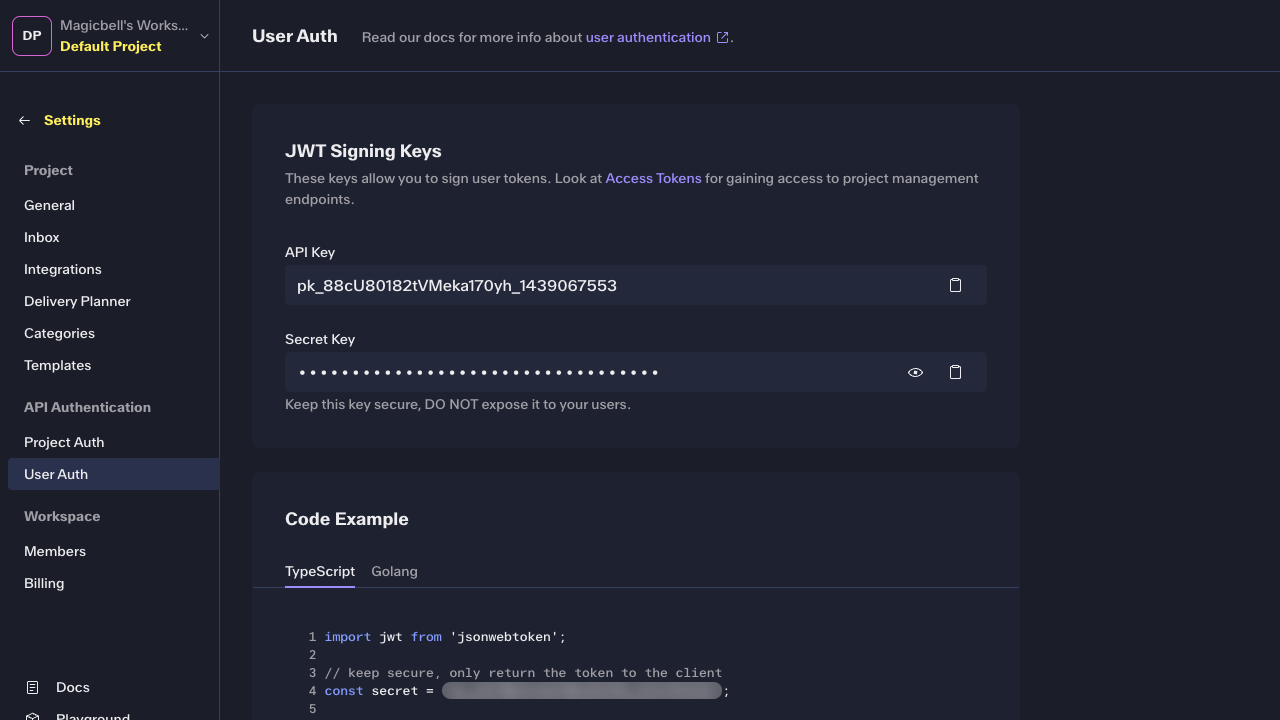User
The User JWT is used to authenticate an end user. You generate it using the Secret Key and the API Key from your project.
Obtaining API Keys
- Go to the MagicBell Dashboard.
- Select your project.
- Navigate to User Auth.
- You’ll see both the API Key and the Secret Key.
Always keep your Secret Key secure. Never expose it in the browser or frontend code.

You’ll need both the API Key and the Secret Key to generate a User JWT.
JWT Payload
Here’s what the payload typically looks like:
{
"user_email": "person@example.com",
"user_external_id": "usr_l70vln",
"api_key": "pk_JJUxO8amaaK21G08w9q0_218239574"
}
You must specify either user_email or user_external_id, or both.
| Key | Description |
|---|---|
user_email |
The email address of the user. Required when no user_external_id is provided. |
user_external_id |
A unique identifier for the user in your system. Required when no user_email is provided. |
api_key |
The API key for your MagicBell project. Obtained via our dashboard |
Signing the User JWT
User JWTs must be signed with your project's Secret Key using the HS256 algorithm. The secret is known only to your backend and MagicBell. It proves the authenticity of the token. The secret key can be obtained from the User Auth page on our Dashboard.
Generate a User JWT
The JWT should be generated by your backend and provided to the frontend.
import jwt from 'jsonwebtoken';
const secret = 'your-secret-key';
const payload = {
user_email: null,
user_external_id: 'your-user-id',
api_key: 'your-api-key',
};
const token = jwt.sign(payload, secret, {
algorithm: 'HS256',
expiresIn: '1y',
});
console.log(token);
package main
import (
"fmt"
"time"
"github.com/golang-jwt/jwt/v5"
)
func main() {
secret := []byte("your-secret-key")
claims := jwt.MapClaims{
"user_email": "",
"user_external_id": "your-user-id",
"api_key": "your-api-key",
"exp": time.Now().AddDate(1, 0, 0).Unix(),
}
token := jwt.NewWithClaims(jwt.SigningMethodHS256, claims)
signed, err := token.SignedString(secret)
if err != nil {
panic(err)
}
fmt.Println(signed)
}
Debugging Tokens
You can use jwt.io to inspect and debug your JWTs. It shows the token's header, payload, and signature, and verifies whether it's correctly signed (if you provide the secret key).
Never paste production secrets into online tools. Only use jwt.io with non-sensitive test data.